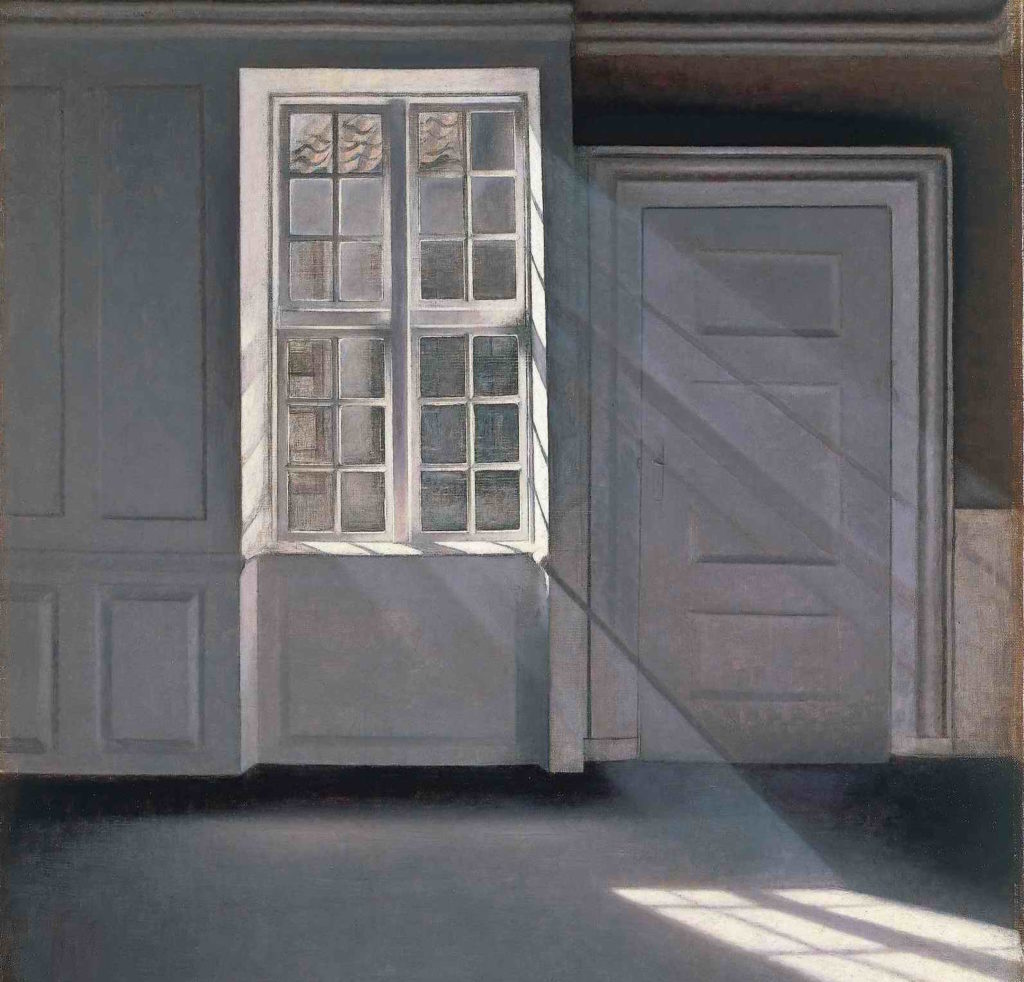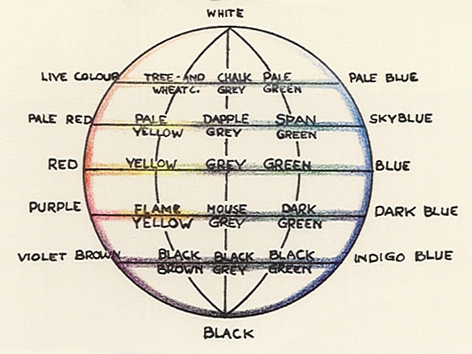Ode to Gray
The color gray is no one’s color. It is the color of cubicles and winter camouflage, of sullage, of inscrutable complexity, of compromise. It is the perfect intermediate, an emissary for both black and white. It lingers, incognito, in this saturated world.
It is the color of soldiers and battleships, despite its dullness. It is the color of the death of trees. The death of all life when consumed by fire. The color of industry and uniformity. It is both artless and unsettling, heralding both blandness and doom. It brings bad weather, augurs bleakness. It is the color other colors fade to once drained of themselves. It is the color of old age.
Because I have no style, I defer to gray. I find it easier to dress in gray scale than to think. I buy in bulk, on sale, in black and white and shades between—some dishwater desolate, some pleasing winter mist. I own at least five cardigans in grandpa gray.
My mother always called me plain. She saw this as a flaw to be corrected. She wanted the whole world dressed in dazzling color—even me. I never quite complied. I have the fashion sense of Vladimir and Estragon and the panache of my New England nana. When left to my devices, I choose to be unobtrusive. I choose gray. It suits my diffidence and soothes my extroversion. It is the color, rather than the sound, of silence. It sits with monkish, folded hands and asks for nothing. It never shouts. It never pushes. As the French painter Jean-Auguste-Dominique Ingres said, “Better gray than garishness.”
I’m drawn to gray, as to a dream, but not to any old gray. Not storm-cloud gray or corporate monolith. I prefer tranquil gray: the undyed wool of sheep in rain, the mood inside a Gerhard Richter painting, the mottle of an ancient cairn. I don’t mean any one gray either but the entire underrainbow of the world, the faded rose and sage and caesious. Liard, lovat, perse. The human eye perceives five hundred—not a mere fifty—shades of gray. Paul Klee called it the richest color, “the one that makes all the others speak.”
*
Ask any schoolkid to list the colors of the rainbow, and she’ll singsong you through your ROYGBIV. Seven colors: red, orange, yellow, green, blue, indigo, and violet. Newton started out with five, then added orange and indigo to sync with music—one for every step between one tonic and the next along a major scale. (Aristotle had seven colors also, but his scale stretched from white to black, not red to violet, and included yellow, crimson, violet, leek green, and deep blue.) Then there are the eleven standard colors taught in schools, which add black, white, brown, pink, and (my beloved) gray. It feels like an addendum, consolation for a color overlooked and undersung.
Before Newton, there was Sigfridus Aronus Forsius, a seventeenth-century Finnish astronomer who made a color wheel into a sphere. He chose five colors: red, yellow, green, blue, and—stretching through them all like ligaments—gray. In Forsius’s model, white and black are polar. His five colors span longitudinally, pale in the northern hemisphere, dark in the south. The prime meridian of this color globe, of course, is gray—the love child of the poles. It is also the color through which all other colors pass. At the center of all color, then: a mass of multicolored gray.
According to Eva Heller, in her Die wahre Geschichte von allen Farben, only 1 percent of people surveyed named gray as their favorite color. I feel, therefore, unique in my perversity, as though I have befriended someone hard to like.
A color psychology article on Bustle tells me that I fear commitment. “Grey is emotionless,” it says, “boring, detached, and indecisive. Those who say their favorite color is grey don’t tend to have any major likes or dislikes.” (False. I majorly like gray.) Lovers of gray “lack the passion that comes with loving a ‘real’ color.” And yet I yearn for it. I fill my drawers with gray brassieres. I dress my bed in sheets and duvets like a day with all the blue drained out of it. The tidiness, the monochrome inspire peace.
Heller deems the color “too weak” to be considered masculine, “too menacing” to be considered feminine. “It is neither warm nor cold, neither material or spiritual.” It can’t make up its mind; perhaps neither can I. Gray is the endless and. It can be cooled or warmed, made magic or mundane. It’s almost always tinged with color, but nothing quite so bold as to commit.
It is also, at least since the first printed photograph in 1826, the color of experience—or what we mean when we say black-and-white. Photography has long been our record of the world, the medium that tells the whole unrepentant truth in perfect detail. And yet for decades, no one seemed to mention what was missing. We were all content with the desaturated version: the texture of reality rendered not in black-and-white but in (five hundred) shades of gray.
As the black-and-white photographer Henri Cartier-Bresson once said to the color photographer William Eggleston: “You know, William, color is bullshit.” In the realism of the black-and-white, gray is every color—without the tartness. The understudies take the stage, and not one seems to miss the headliners. We see the world without distraction. Andre Gide called gray the color of the truth.
Look at enough black-and-white photography and color comes to feel like an intrusion. Eggleston’s photos seem too vital to be real, as though depicting an alternate reality. Each image is delirious with hue, spectacular, delicious, but a little bit too much. The eye craves rest—and mystery, the kind of truth that can be searched only in subtlety. Dorothy may tumble, tornadic, into Technicolor, but still she always wishes to go home.
*
We assume wrongly that gray is flat; we’ve been conditioned to do so. Even Wittgenstein denounced it, found it lacking luminosity. But his gray was conceptual, a fiction. As David Batchelor would write, “A grey of the mind is largely an absence—of colour, of interest, of warmth, of desire, of life—whereas a grey in the world is always a presence.” Goethe might be right that gray “is all theory” because theory itself is gray; the theory of gray, therefore, is also gray. The reality of gray is not.
Gray in the wild opens and spills. Put two grays together and you’ll see the color each one hides within, the “endless variations” noted by Van Gogh. I think of the handful of river pebbles I once snuck into my pockets on a day trip to a waterfall: they were dusty gray when I got home, but underwater, each concealed a secret separate life as green or red or blue. So many things that seem gray on the surface have a treasure to unlock—myself, I hope, included.
The Bauhaus painter Johannes Itten writes that gray is “mute, but easily excited to thrilling resonances.” Infuse it with a touch of any other color and it transforms itself from “sterile neuter.” You don’t expect to find emotion in the gray, but there it is. Beneath the “dampness, dishwater and disappointment,” there it is. Surprise.
*
Where I live in California, the good weather is oppressive—with each day bluer and more vivid than the next. Sometimes the rare gray morning dawns, clouded and tenuous, and the world is hushed. I hear only the doleful hooting of the mourning dove, the bird who understands me best. By noon, inevitably, sun and cyan have burnt through. The great brass band of color strikes up once again. Flowers perk up; leaves are lit ablaze. Here, in living color, Kodachrome, the glory of the world. I fight a pang of mourning for the leaden sky, as though a friend has left.
I sometimes drive an hour to the ocean, hoping I will find it thoroughly obscured by fog. I am not a melancholic or a bore, but I want a break from all the rainbow violence in the world. To scratch beneath the surface to the quiet central core of Forsius’s color sphere.
Derek Jarman writes, “Grey is the sad world into which the colours fall.” But he also writes that gray is where color “sings.” It is the perfect neutral, balanced and dignified—and yet it is so effortlessly swayed; it is the pool that takes in other colors as they bleed. It complements; it brightens light and lightens dark. It isn’t flat. It’s deep, endlessly deep. Gray is the dark end of the light. The light end of the dark. Unsettling, perhaps, but full of possibility. Just think how beautiful we all look in the gloaming. It’s liminal, the color of our own potential to become.
Meghan Flaherty is the author of Tango Lessons (Houghton Mifflin Harcourt). Her essays have appeared in The Iowa Review, Psychology Today, the New York Times, The Rumpus, Catapult, and elsewhere.


No comments:
Post a Comment